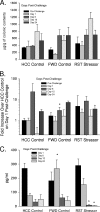Stressor exposure disrupts commensal microbial populations in the intestines and leads to increased colonization by Citrobacter rodentium
- PMID: 20145094
- PMCID: PMC2849416
- DOI: 10.1128/IAI.00862-09
Stressor exposure disrupts commensal microbial populations in the intestines and leads to increased colonization by Citrobacter rodentium
Abstract
The gastrointestinal tract is colonized by an enormous array of microbes that are known to have many beneficial effects on the host. Previous studies have indicated that stressor exposure can disrupt the stability of the intestinal microbiota, but the extent of these changes, as well as the effects on enteric infection, has not been well characterized. In order to examine the ability of stressors to induce changes in the gut microbiota, we exposed mice to a prolonged restraint stressor and then characterized microbial populations in the intestines using both traditional culture techniques and bacterial tag-encoded FLX amplicon pyrosequencing (bTEFAP). Exposure to the stressor led to an overgrowth of facultatively anaerobic microbiota while at the same time significantly reducing microbial richness and diversity in the ceca of stressed mice. Some of these effects could be explained by a stressor-induced reduction in the relative abundance of bacteria in the family Porphyromonadaceae. To determine whether these alterations would lead to increased pathogen colonization, stressed mice, as well as nonstressed controls, were challenged orally with the enteric murine pathogen Citrobacter rodentium. Exposure to the restraint stressor led to a significant increase in C. rodentium colonization over that in nonstressed control mice. The increased colonization was associated with increased tumor necrosis factor alpha (TNF-alpha) gene expression in colonic tissue. Together, these data demonstrate that a prolonged stressor can significantly change the composition of the intestinal microbiota and suggest that this disruption of the microbiota increases susceptibility to an enteric pathogen.
Figures








References
-
- Acosta-Martinez, V., S. Dowd, Y. Sun, and V. Allen. 2008. Tag-encoded pyrosequencing analysis of bacterial diversity in a single soil type as affected by management and land use. Soil Biol. Biochem. 40:2762-2770.
-
- Bailey, M., H. Engler, J. Hunzeker, and J. F. Sheridan. 2003. The hypothalamic-pituitary-adrenal axis and viral infection. Viral Immunol. 16:141-157. - PubMed
-
- Bailey, M. T., and C. L. Coe. 1999. Maternal separation disrupts the integrity of the intestinal microflora in infant rhesus monkeys. Dev. Psychobiol. 35:146-155. - PubMed
-
- Bailey, M. T., G. R. Lubach, and C. L. Coe. 2004. Prenatal stress alters bacterial colonization of the gut in infant monkeys. J. Pediatr. Gastroenterol. Nutr. 38:414-421. - PubMed
Publication types
MeSH terms
Grants and funding
LinkOut - more resources
Full Text Sources
Other Literature Sources

